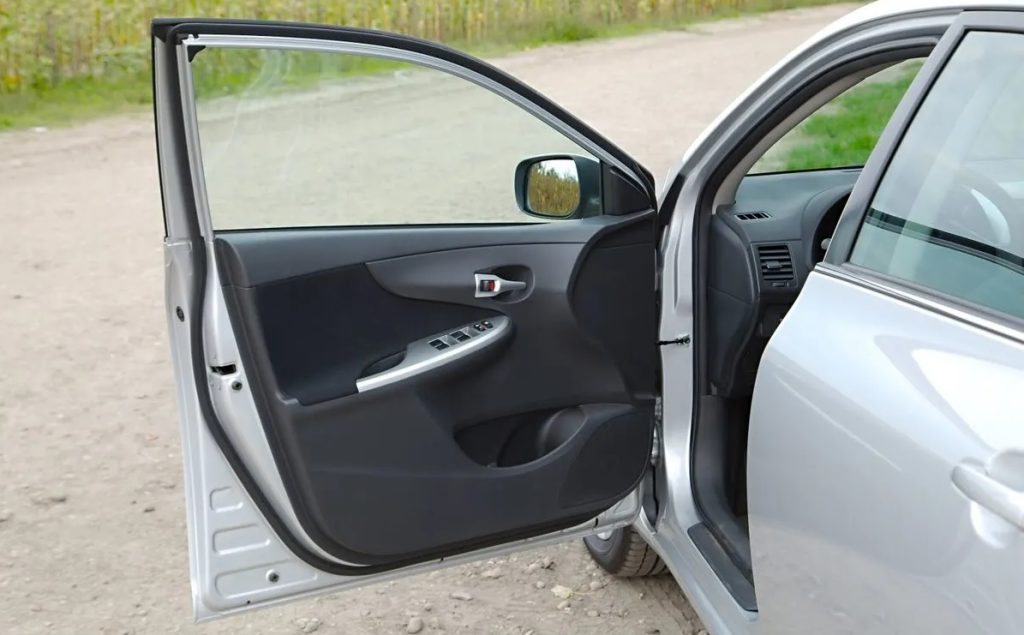In the fast-paced world of automotive engineering, the materials chosen for constructing car doors stand as a testament to the constant pursuit of safety, durability, and innovation. This comprehensive guide aims to take you on a deep dive into the intricate world of car door materials, unraveling the complexities and shedding light on the key factors influencing these crucial decisions.
The Significance of Car Door Materials
Car doors are not mere functional components; they are integral to the structural integrity of a vehicle. Beyond being entry points, these doors serve as critical elements that contribute to the overall safety, weight, fuel efficiency, and environmental impact of a car.
1. Steel: The Tried-and-True Workhorse
Steel has been the backbone of car door construction for decades. Renowned for its robustness, steel provides an impenetrable barrier, enhancing occupant safety during collisions. Traditional as it may be, ongoing advancements continue to refine the use of steel in modern automobiles.
While steel is celebrated for its strength, it does come with a trade-off in weight. As the automotive industry strives for more fuel-efficient vehicles, engineers are exploring ways to maintain steel’s structural benefits while mitigating its impact on overall vehicle weight.
2. Aluminum: A Leap Towards Lightweight Efficiency
In the quest for lighter and more fuel-efficient vehicles, aluminum has emerged as a formidable alternative to steel. Its lightweight nature doesn’t compromise on strength, contributing to improved fuel efficiency without sacrificing safety.
The use of aluminum in car doors is a testament to the industry’s commitment to finding the delicate balance between safety, weight, and performance. Manufacturers are continually optimizing aluminum alloys to ensure they meet stringent safety standards while embracing the benefits of reduced vehicle weight.
3. Composite Materials: Blending Strength with Creativity
The advent of composite materials has ushered in a new era of innovation in car door construction. Materials such as fiberglass and carbon fiber offer a unique blend of strength and versatility, allowing for creative designs while maintaining structural integrity.
The allure of composite materials lies in their ability to combine various elements to create a material that is stronger and lighter than traditional options. This flexibility allows for greater design freedom, contributing to both aesthetic appeal and functional efficiency.
Factors Guiding Material Choices
4. Safety Standards: Pinnacle of Decision-Making
Ensuring compliance with rigorous safety standards is a non-negotiable priority for automakers. The materials chosen for car doors must not only meet but exceed regulatory requirements to guarantee the highest level of protection for vehicle occupants.
The integration of advanced safety features, such as side-impact beams and crumple zones, further underscores the commitment to passenger safety. These features work in tandem with carefully chosen materials to enhance a car’s ability to withstand and dissipate the forces generated during a collision.
5. Weight Distribution: Finding Harmony on the Road
Balancing a car’s weight distribution is a delicate dance that significantly impacts its handling and overall performance. Materials that are both strong and lightweight contribute to optimal weight distribution, enhancing the vehicle’s maneuverability and stability on the road.
The ongoing challenge for engineers is to strike the right balance between safety and weight. Advanced simulations and testing methods help fine-tune material choices, ensuring that vehicles not only meet safety standards but also deliver a satisfying driving experience.
6. Environmental Impact: Toward Greener Automotive Solutions
With a growing emphasis on environmental sustainability, car manufacturers are actively seeking eco-friendly materials for their vehicles. Sustainable options not only reduce the overall carbon footprint but also align with consumer preferences for greener automotive choices.
Materials like recycled steel and aluminum contribute to reducing the environmental impact of car production. Additionally, the exploration of biodegradable materials holds promise for minimizing the ecological footprint of automotive components, including car doors. (See Also: What Does Ventilated Seats Mean? A Comprehensive Guide)
The Technological Landscape of Car Door Materials
7. Smart Materials: Enhancing Crash Resistance
The integration of smart materials into car door construction represents a significant leap forward in automotive safety. These materials, including shape-memory alloys, respond dynamically to external forces, enhancing crash resistance and improving overall safety.
Smart materials have the ability to change shape or properties in response to specific stimuli, providing an additional layer of protection during a collision. As technology advances, we can expect to see further innovations in the integration of smart materials to enhance the safety features of car doors.
8. Nanotechnology: A Minuscule Revolution
Nanotechnology is making waves in the automotive industry, influencing the construction of car doors at the molecular level. Nanomaterials exhibit exceptional strength and durability, offering a new frontier for automotive engineers seeking cutting-edge solutions.
The use of nanomaterials in car door construction allows for a more precise and tailored approach to material design. This level of precision enhances the structural integrity of car doors, contributing to improved safety and performance.
The Future Horizon of Car Door Materials
9. 3D Printing: A Manufacturing Revolution
As 3D printing technology continues to evolve, it holds the potential to revolutionize car door manufacturing. The ability to create intricate and customized designs using various materials opens up exciting possibilities for the future of automotive engineering.
3D printing enables the production of complex geometries that were previously challenging or impossible with traditional manufacturing methods. This not only allows for greater design flexibility but also streamlines the manufacturing process, potentially reducing waste and energy consumption.
10. Biodegradable Materials: A Confluence of Innovation and Sustainability
The quest for sustainable solutions extends to the exploration of biodegradable materials for car doors. These materials aim to minimize the environmental impact throughout a vehicle’s lifecycle, from production to disposal.
Biodegradable materials, often derived from renewable sources, offer a potential solution to the environmental challenges associated with traditional car door materials. As technology advances, we may witness an increased adoption of biodegradable options in the automotive industry.
Expert Tips for Choosing the Right Material for Car Doors
Selecting the ideal material for your car doors is a critical decision that impacts not only the safety of your vehicle but also its overall performance. To guide you through this intricate process, here are some expert tips to consider when choosing the right material for your car doors.
1. Prioritize Safety Without Compromise
Safety should be at the forefront of your decision-making process. Opt for materials that not only meet but exceed safety standards. Consider how the chosen material contributes to features like crumple zones and side-impact resistance, enhancing overall occupant protection during collisions.
2. Balance Weight for Optimal Performance
Striking the right balance between strength and weight is crucial. While lightweight materials contribute to better fuel efficiency, it’s essential to ensure that they don’t compromise the overall structural integrity of the car. Aim for materials that enhance weight distribution, positively impacting the vehicle’s handling and performance on the road.
3. Stay Informed About Technological Advancements
Keep a keen eye on technological advancements in car door materials. Smart materials and nanotechnology are reshaping the landscape, offering enhanced crash resistance and structural integrity. Stay informed about these innovations to make future-proof decisions for your vehicle. (See Also: How to Change Car Interior Color: Ultimate Guide for a Stunning Transformation)
4. Consider the Environmental Impact
In an era of environmental consciousness, consider the environmental impact of your car door material choices. Explore sustainable options such as recycled steel and aluminum, or even biodegradable materials. Choosing eco-friendly materials aligns with the global push for greener automotive solutions.
5. Embrace Innovation with 3D Printing
Explore the possibilities offered by 3D printing technology. This revolutionary manufacturing process allows for intricate and customized designs, providing a new frontier for creative and efficient car door construction. Embrace the potential of 3D printing to stay at the forefront of automotive innovation.
6. Evaluate Long-Term Durability
Assess the long-term durability of the chosen material. Consider factors like resistance to corrosion, wear and tear, and overall longevity. Investing in durable materials ensures that your car doors maintain their structural integrity over time, contributing to the longevity of your vehicle.
7. Consult Manufacturer Recommendations
Consult your vehicle manufacturer’s recommendations for car door materials. Manufacturers often have specific guidelines and insights into the optimal materials for their vehicles. Following these recommendations ensures that your choices align with the engineering standards set by the manufacturer.
8. Explore Customization Possibilities
With advancements in materials and manufacturing processes, explore customization possibilities for your car doors. This not only allows for a personalized aesthetic but can also contribute to the overall uniqueness of your vehicle. Check with manufacturers or specialized shops that offer customization services.
9. Stay Mindful of Cost Considerations
While prioritizing safety and performance, it’s essential to remain mindful of cost considerations. Different materials come with varying price tags, and understanding the cost implications of your choices ensures that they align with your budget without compromising on essential factors.
10. Seek Professional Advice
When in doubt, seek professional advice. Consulting with automotive engineers or specialists can provide valuable insights into the best material choices for your specific vehicle and driving needs. Their expertise can guide you through the complex decision-making process, ensuring you make an informed choice.
Making informed decisions about car door materials involves considering a myriad of factors. By following these expert tips, you’ll navigate the intricate landscape of automotive materials, ultimately choosing the right material that aligns with safety, performance, and your individual preferences.
FAQs: Decoding the Mysteries of Car Door Materials
Navigating the realm of car door materials can be a perplexing journey, filled with questions about safety, innovation, and sustainability. In this FAQ section, we unravel the mysteries surrounding car door materials, providing answers to common queries and shedding light on the key considerations.
Q1: Why is the choice of car door material important?
A1: The choice of car door material is crucial as it directly impacts the safety, performance, and environmental footprint of a vehicle. Different materials offer varying levels of strength, weight, and durability, influencing overall vehicle design and occupant protection.
Q2: Which material is the safest for car doors?
A2: Safety often depends on a combination of factors, but traditional materials like high-strength steel and advanced alloys, along with innovative options like smart materials, contribute to enhanced crash resistance and occupant protection.
Q3: How does the weight of car door materials affect performance?
A3: The weight of car door materials influences the overall weight distribution of a vehicle, impacting its handling, fuel efficiency, and performance. Striking the right balance between strength and weight is essential for optimal driving dynamics.
Q4: Are there eco-friendly options for car door materials?
A4: Yes, there are eco-friendly options, including recycled steel, aluminum, and even biodegradable materials. Choosing sustainable materials aligns with the automotive industry’s push towards greener solutions and reduced environmental impact. (See Also: Where to Buy 3M Adhesive Remover? Top Tips and Trusted Sellers)
Q5: What role does technology play in car door materials?
A5: Technology, such as smart materials and nanotechnology, plays a significant role in enhancing the safety and performance of car doors. These innovations provide advanced features like shape-memory alloys and molecular-level strength, contributing to overall vehicle durability.
Q6: Can I customize the material of my car doors?
A6: Yes, advancements in manufacturing processes, including 3D printing, offer opportunities for customization. You can explore personalized designs and materials, but it’s crucial to ensure that customized options meet safety and regulatory standards.
Q7: Do car manufacturers provide recommendations for door materials?
A7: Yes, car manufacturers often provide recommendations based on their engineering standards. Following these guidelines ensures that your material choices align with the specifications and safety features designed for your specific vehicle model.
Q8: Are lightweight materials as safe as heavier ones?
A8: While lightweight materials like aluminum can be as safe as heavier options, it depends on the specific design and engineering of the vehicle. Modern manufacturing techniques allow for the creation of lightweight materials that maintain high levels of strength and safety.
Q9: What is the future of car door materials?
A9: The future of car door materials holds exciting possibilities, including further advancements in smart materials, nanotechnology, and 3D printing. Sustainable options and innovative materials are expected to play a significant role in shaping the automotive landscape.
Q10: How can I make an informed decision about car door materials?
A10: To make an informed decision, prioritize safety, consider the environmental impact, stay informed about technological advancements, and, when in doubt, consult with automotive professionals. Understanding the specific needs of your vehicle and personal preferences will guide you towards the right material choice.
Conclusion: Navigating the Material Maze Towards a Safer, Greener Future
In conclusion, the choice of materials for car doors is a dynamic and multifaceted aspect of automotive design. Whether it’s the steadfast strength of steel, the lightweight allure of aluminum, or the innovative potential of smart materials and nanotechnology, each option contributes to the ever-evolving landscape of automotive engineering.
As consumers, understanding the intricacies of car door materials empowers us to make informed decisions when selecting vehicles. It also encourages manufacturers to push the boundaries of what’s possible, fostering advancements in safety, performance, and environmental sustainability.
In this journey through the material maze, we’ve explored the traditional and the cutting-edge, the sturdy and the lightweight, all converging towards a common goal: safer, more efficient, and environmentally friendly automobiles. The future holds exciting possibilities as technology continues to shape the landscape of car door materials, paving the way for a new era of automotive innovation.



